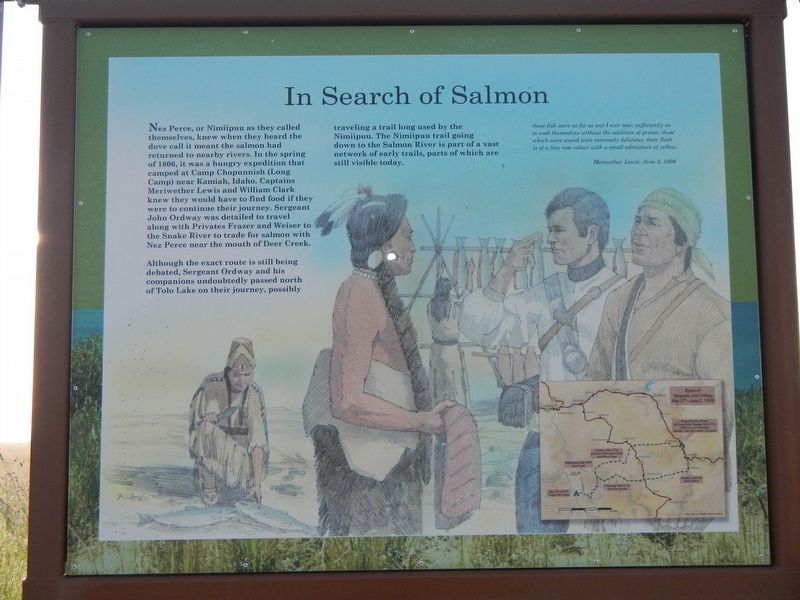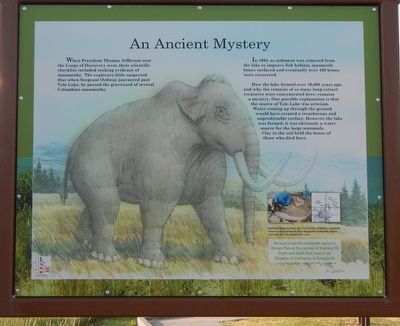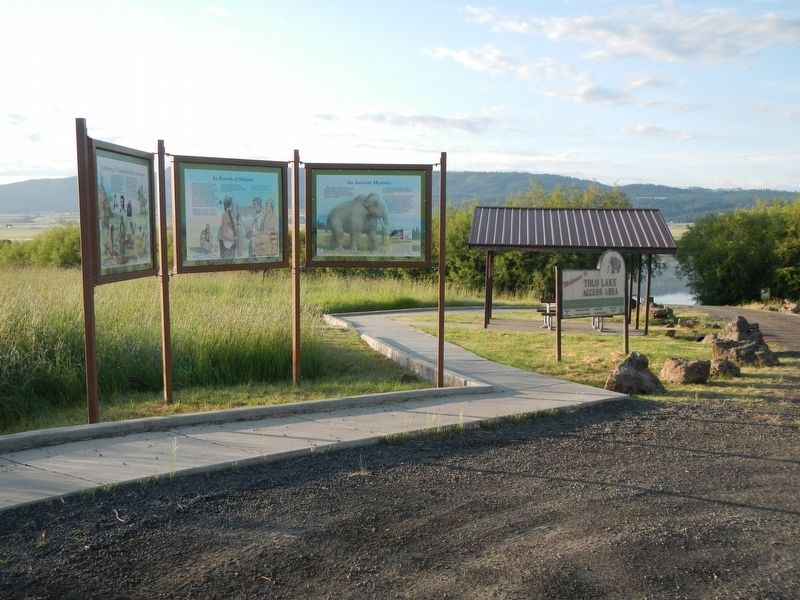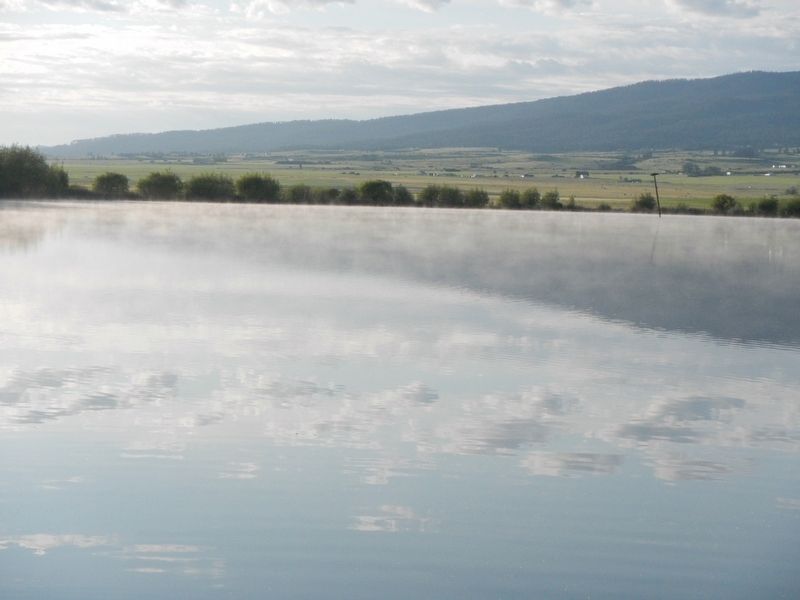Grangeville in Idaho County, Idaho — The American West (Mountains)
Gathering at Tipahxlee’whum (Tepahlewam)
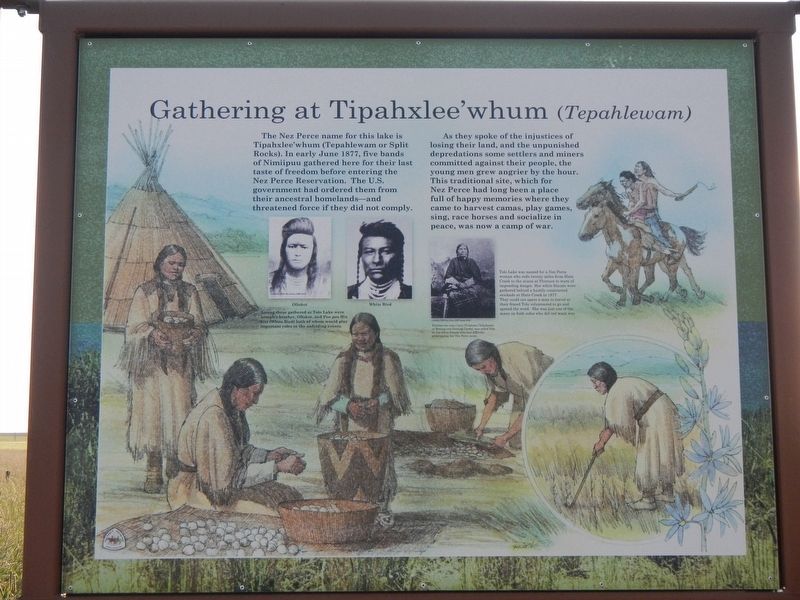
Photographed By Barry Swackhamer, May 5, 2018
1. Gathering at Tipahxlee’whum (Tepahlewam) Panel
Captions: (two photos at center left) Among those who gathered at Tolo Lake were Joseph's brother, Ollokot, and Peo peo His hiix (White Bird) both of whom would play important roles in the unfolding events.; (photo at center right) Tulekeec'esa ceex c'emit (Tulekats Chikchamit or Betting and Dealing Cards), was called Too by her white friends who had difficulty pronouncing her Nez Perce name.
The Nez Perce name for this lake is Tipahxlee’whum (Tepahlewam or Split Rocks). In early June 1877, five bands of Nimiipuu gathered here for their last taste of freedom before entering the Nez Perce Reservation. The U.S. government had ordered them from their ancestral homelands - and threatened force if they did not comply.
As they spoke of the injustices of losing their land, and the unpunished depredations some settlers and miners committed against their people, the young men grew angrier by the hour. This traditional site, which for Nez Perce had long been a place full of happy memories where they came to harvest camas, play games, sing, race horses and socialize in peace, was now a camp of war.
Tolo Lake was named for a Nez Perce woman who rode twenty miles from Slate Creek to the mines at Florence to warn of impending danger. Her white friends were gathered behind a hastily constructed stockade at Slate Creek in 1877. They could not spare a man to travel so their friend Tolo volunteered to go and spread the word. She was just one of the many on both sides who did not want war.
Nez Perce, or Nimiipuu as they called themselves, knew when they heard the dove call it meant the salmon had returned to nearby rivers. In the spring of 1806, it was a hungry expedition that camped at Camp Chopunnish (Long Camp) near Kamiah, Idaho. Captains Meriwether Lewis and William Clark knew they would have to find food if they were to continue their journey. Sergeant John Ordway was detailed to travel along with Privates Frazer and Weiser to the Snake River to trade for salmon with Nez Perce near the mouth of Deer Creek.
Although the exact route is still being debated, Sergeant Ordway and his companions undoubtedly passed north of Tolo Lake on their journey, possibly traveling a trail long used by the Nimiipuu. The Nimiipuu trail going down to the Salmon River is part of a vast network of early trails, parts of which are still visible today.
these fish were as fat as any I ever saw; sufficiently so to cook themselves without the addition of grease; those which were sound were extremely delicious; their flesh is of a fine rose colour with a small admixture of yellow. -- Meriwether Lewis, June 2, 1806
When President Thomas Jefferson sent the Corps of Discovery west, their scientific checklist included seeking evidence of mammoths. The explorers little suspected that when Sergeant Ordway journeyed past Tolo Lake, he passed the graveyard of several Columbian mammoths.
In 1994, as sediment was removed from the lake to improve fish habitat, mammoth bones surfaced and eventually over 400 bones were recovered.
How the lake formed over 10,000 years ago, and why the remains of so many long-extinct creatures were concentrated here, remains a mystery. One possible explanation is that the source of Tolo Lake was artesian. Water coming up through the ground would have created a treacherous and unpredictable surface. However the lake was formed, it was obviously a water source for the large mammals. Clay in the soil held the bones of those who died here.
Be sure to see the mammoth replica in Elmers Park at the junction of Highway 95 North and North Pine, next to the Chamber of Commerce in Grangeville.
Erected by Nez Perce Nee-Me-Poo National Historical Park.
Topics and series. This historical marker is listed in these topic lists: Exploration • Native Americans • Paleontology • Wars, US Indian. In addition, it is included in the Lewis & Clark Expedition, and the The Nez Perce Trail series lists.
Location. 45° 54.881′ N, 116° 14.335′ W. Marker is in Grangeville, Idaho, in Idaho County. Marker can be reached from Lake Road near Tolo Lake Road, on the left
when traveling south. Touch for map. Marker is in this post office area: Grangeville ID 83530, United States of America. Touch for directions.
Other nearby markers. At least 8 other markers are within 6 miles of this marker, measured as the crow flies. Camas Prairie (approx. 2.7 miles away); White Bird Grade (approx. 5.1 miles away); Salmon River (approx. 5.2 miles away); A Mammoth Discovery (approx. 5.3 miles away); The Camas Connection (approx. 5.3 miles away); Gold Pans and Whipsaws (approx. 5.3 miles away); The Camas Prairie Mammoth (approx. 5.3 miles away); Home on the Grange (approx. 5.3 miles away). Touch for a list and map of all markers in Grangeville.
More about this marker. The marker is located near the boat launch ramp.
Credits. This page was last revised on August 7, 2018. It was originally submitted on August 7, 2018, by Barry Swackhamer of Brentwood, California. This page has been viewed 365 times since then and 26 times this year. Photos: 1, 2, 3, 4, 5. submitted on August 7, 2018, by Barry Swackhamer of Brentwood, California.
